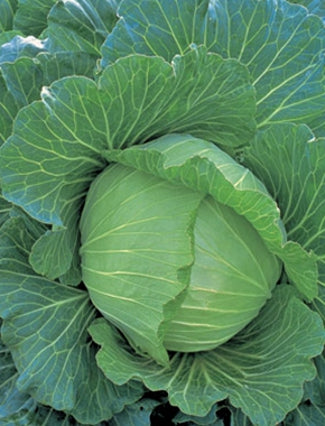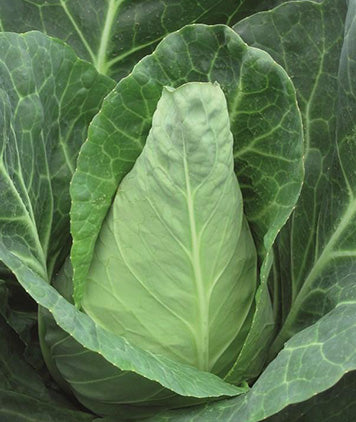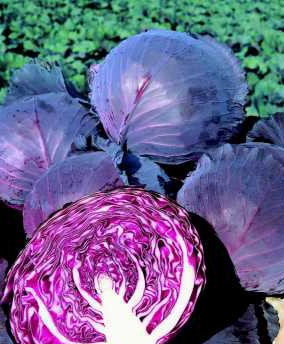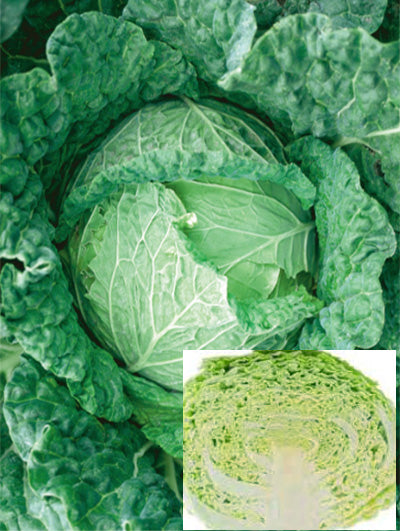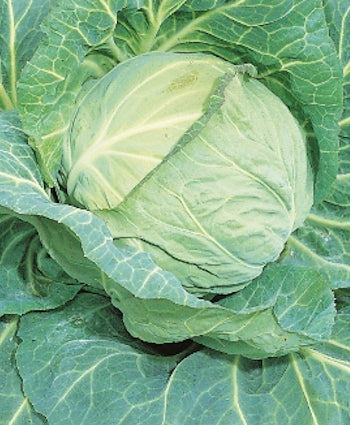How to Grow Cabbage

Meet the cabbage clan:
- Ballhead/Drumhead (green or red) – tight, round heads with a sweet-earthy crunch. Versatile: shred for coleslaw, ferment into sauerkraut, braise or grill wedges.
- Savoy – crinkled emerald leaves, super-tender with a mild, nutty taste; perfect for stir-fries, winter slaws and cabbage rolls. Grows best in cool weather.
- Sugarloaf/Pointed (cone) – elongated, pale-green heads that mature fast and stay sweet in early heat; great raw in salads or quick sautés.
- Chinese/Napa (wombok) – tall, loose heads of juicy, mild leaves ideal for kimchi, dumpling fillings and light soups. Prefers autumn sowing and even moisture.
Seeds per gram (Sds/g): 280–340
Germination Temperature: 10–24 °C (ideally 18 °C); sprouts appear in 6-10 days.
Feed Requirements:
- Moderate for large, late (winter) varieties
- High for smaller, spring/early varieties
Position & Soil:
-
Soil Type & pH:
- Prefers well-drained, fertile soil with a pH of 6.5–7.0.
- Incorporate organic matter (e.g., compost or well-rotted manure) for best yields.
-
Sun Exposure:
- Full sun is ideal. Partial shade may slow growth slightly but can help in hot climates.
-
Moisture:
- Provide consistent, even watering throughout the growing season.
-
Large fluctuations in moisture can cause heads to split.
Sowing & Germination
-
Sowing Depth & Spacing:
- Sow 3–5 seeds per spot, 0.5 cm–1 cm deep, then thin to leave the healthiest seedling.
- Spacing depends on variety size:
- Small, early cabbages: 50 cm × 50 cm (or 60 cm × 60 cm for slightly larger heads).
- Main-season & late varieties: 75–90 cm between plants for bigger heads.
-
Sowing Times (Temperate/Tasmania):
- Early Cabbages (e): Sow or transplant from mid-September.
- Main-Season: Plant from late October through December.
- Late Cabbage: Sow from late December to mid-February (choose quicker-maturing varieties if sowing later).

-
Asian Cabbages (e.g., Wong Bok):
- Generally grown in cooler months (autumn into winter).
- Bolts (goes to seed) quickly in heat.
- Cool weather also enhances flavor.
-
Germination Tips:
- Cabbage seeds typically germinate best in temperatures around 15–25 °C.Keep soil evenly moist but not waterlogged.
Cultivation & General Care
-
Feeding:
- Cabbages are heavy feeders.
- Use well-rotted manure or a balanced organic fertilizer before planting.
- Supplement with an additional feed during head formation, especially for larger, later varieties.
-
Watering:
- Water thoroughly and consistently to encourage steady growth.
- Avoid letting soil dry out, as sudden changes in water availability can cause splitting.
-
Weeding & Mulching:
- Keep the area weed-free, as weeds compete for nutrients.
- A light mulch (straw or compost) helps maintain moisture and reduce weeds.
-
Pest & Disease Control:
- Slugs & Snails: Especially problematic in warm, moist conditions—use traps or handpick.
- Cabbage Moth: Spray Dipel (Bacillus thuringiensis) regularly to control caterpillars or use netting so they cannot lay eggs on the leaves.
- Good garden hygiene and crop rotation help reduce brassica pests and diseases.
Potential Problems
- Splitting Heads: Occurs due to sudden or excessive water uptake after a dry spell. Harvest promptly once heads are mature.
- Poor Heading: May be caused by crowding or insufficient nutrients. Ensure correct spacing and adequate feeding.
- Bolting (Asian Cabbages): Happens if temperatures are too warm. Grow these varieties in cooler months.
Harvesting & Storage:
-
When to Harvest:
- Early Varieties: Mature quickly; harvest promptly to avoid splitting.
- Main & Late Varieties: Grow larger, develop more slowly, and can hold longer in the ground (especially late summer or autumn).
- Ballhead/Red/Savoy/Sugarloaf: Harvest when heads feel solid. Cut at the base with a sharp knife, leaving outer stump; small secondary heads may sprout on ballhead stumps.
- Chinese/Napa/Wong Bok: Lift whole heads once they have filled out and are firm
-
How to Harvest:
- Cut heads at the base with a sharp knife when firm and well-formed.
- Remove loose outer leaves.
-
Storage:
- Late varieties often store best, both in-ground and post-harvest.
- Store in a cool, dark place or the refrigerator for several weeks.
- Savoy and Chinese varieties do not keep as long – enjoy within a fortnight or ferment into kimchi or sauerkraut for long-term flavour.
Additional Tips & Notes:
-
Succession Planting:
- To ensure a continuous supply of fresh cabbage, stagger plantings of early, main-season, and late varieties.
-
Asian Cabbages:
- “Wong Bok” and other fast-growing types do best in cooler weather. Harvest them promptly to avoid bolting.
By ensuring consistent moisture, proper spacing, and adequate feeding, gardeners can enjoy a bountiful crop of both early and late-season cabbages.
Sowing Periods
| J | F | M | A | M | J | J | A | S | O | N | D | |
|---|---|---|---|---|---|---|---|---|---|---|---|---|
| Cool | ||||||||||||
| Temperate | ||||||||||||
| Sub-Tropical/Tropical |
Filters
10 products
Cabbage 'Copenhagen Market'
Sale price$3.75
Cabbage ‘Caraflex’ F1
Sale price$3.75
Cabbage ‘Golden Acre’
Sale price$3.75
CABBAGE ‘Red Express’
Sale price$3.75
CABBAGE ‘Ruby Perfection’ F1
Sale price$3.75
CABBAGE ‘Savoy King’ F1
Sale price$3.75
CABBAGE ‘Spring Hero’ F1
Sale price$3.95
Cabbage, Savoy ‘Munchkin’ F1
Sale price$3.75
CABBAGE, Savoy ‘Vertus’
Sale price$3.75
CHINESE CABBAGE ‘Wong Bok'
Sale price$3.75

